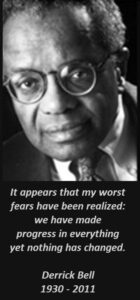Derrick Bell can be said to be the creator of critical race theory (CRT). As an academic discipline, it is rather new, but it is similar to prior assessments of race in America. The basic premise of the theory is that society is divided between oppressors (whites) and victims (blacks). As such, it follows the framework of dialectical analysis struggle created by G. W. F. Hegel and further developed by Karl Marx.
The difference is that classic Marxist analysis focuses on social class as the foundational unit for social hierarchies, with other elements forming a superstructure of epiphenomena that includes race. To understand oppression, classic Marxism enjoins the use of no other reality but social class. In the racialist neo-Marxist framework of CRT, however, race is not reducible to class, although some CRT identifies the oppressor/victim dichotomy along class lines. Thus, alienation, antagonism, and oppression are presented within various basic models that supplant social class.
Again, not all CRT advocates understand race as a substitute for class. They might focus on class as a particularly powerful oppressive phenomenon arising from the struggles of race but they remain committed to the basic classical Marxist reading of history. Although it is not completely clear, Black Lives Matter seems to reject the notion that race is not reducible to class. That is why some of its founders present the struggle of race as a “front” among other fronts. For its founders, gender is yet another front. This language can only make sense if both race and gender oppressions arise from more foundational realities.
We must remember that the notion of a united front comes from Lenin, who understood the importance of a war against capitalism that encompasses various struggles against the multiple expressions of oppression birthed from the antagonisms of class.
 In the contention of CRT, America is an inherently and permanently racist society, whose very foundation is based on racial oppression. Race, not class, gave rise to class stratification and the alienation of “inferior” races. Consequently, America’s political, social, and legal systems are by definition racist and unjust. They are not valid and must be replaced.
In the contention of CRT, America is an inherently and permanently racist society, whose very foundation is based on racial oppression. Race, not class, gave rise to class stratification and the alienation of “inferior” races. Consequently, America’s political, social, and legal systems are by definition racist and unjust. They are not valid and must be replaced.
As Emory University professor Dorothy Brown puts it, critical race theory “seeks to highlight the ways in which the law is not neutral and objective but designed to support white supremacy and the subordination of people of color.” By design, the legal structure of the nation is racist and CRT consists of finding the multiple tentacles of that monster. It tirelessly offers a litany of oppressions with the a priori belief that every aspect of the law is tainted with racism, even if it seems to be balanced and race-blind. In this view, it is inherently racist and it has built a life of its own that revolves around newer oppressions.
A logical derivative of this premise, according to CRT, is that it is unjust to offer allegiance to such a system and that members of “oppressed” racial groups have an obligation to be selective in terms of what they choose to accept as law. They are entitled to determine for themselves which laws and traditions have validity and are worth observing. They possess racial epistemic insight that arises from being members of the oppressed group.
Just as, in classic Marxism, the worker or proletarian is the only one capable of gaining class consciousness and insight into his oppression, in CRT the racial victim, although part of the universe being discussed, must be the one deciding what is true and what is false. The very notion of objectivity, which demands distance between the universe being observed and the examiner, is a form of oppression that demands that the racial victim surrender his privileged epistemic position.
Further, CRT holds that because racism is so deeply ingrained in the American character, classical liberal ideals such as equality, freedom, meritocracy, and justice are essentially nothing more than empty words that fail to properly oppose the structural inequities that pervade American society. Instead, these ideas are themselves instruments of racial oppression. Thus, a number of reforms, such as racial preferences in education and employment, are necessary as a means of countering the permanent bigotry of white people who, as Bell put it, seek to “achieve a measure of social stability through their unspoken pact to keep blacks on the bottom.”
Now, for advocates of CRT these changes, although necessary, are not going to reform a system that is irreformable. They simply pave the way for the complete transformation of the system and its ultimate demise and substitution. The falsity of critical race theory is not in its general observations of injustice but in the way it frames the entire question of racism in America. This is exactly why the theory ultimately fails.



